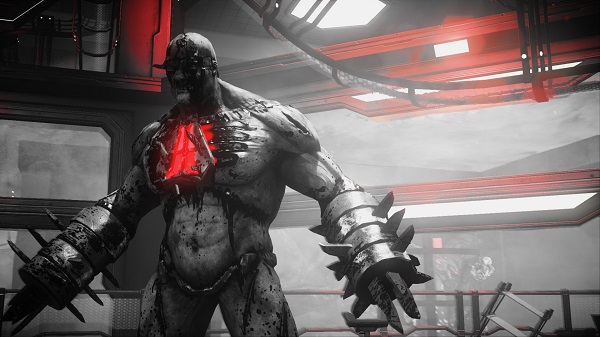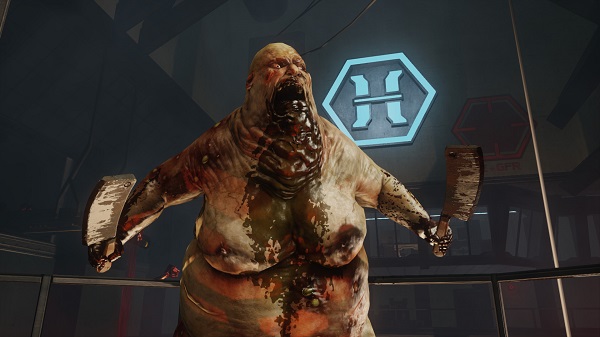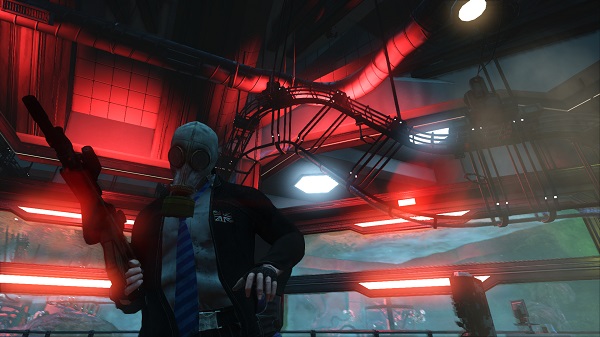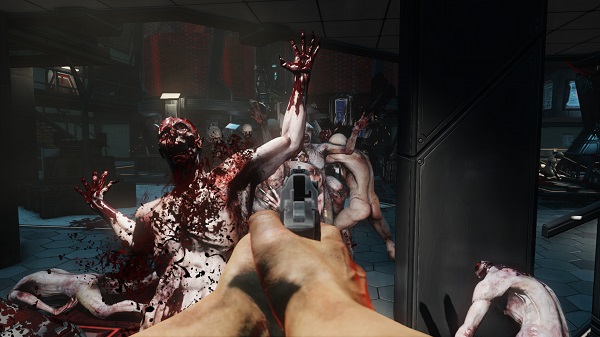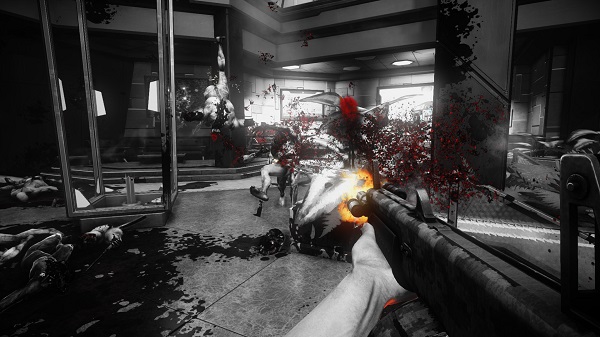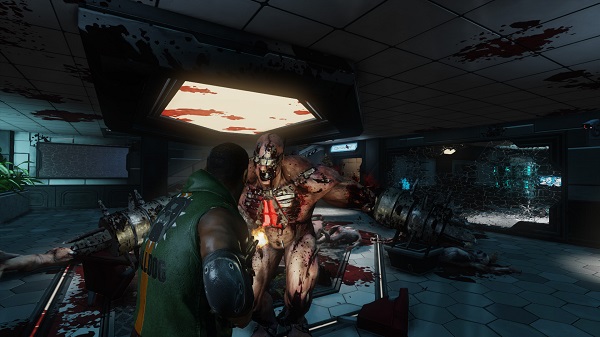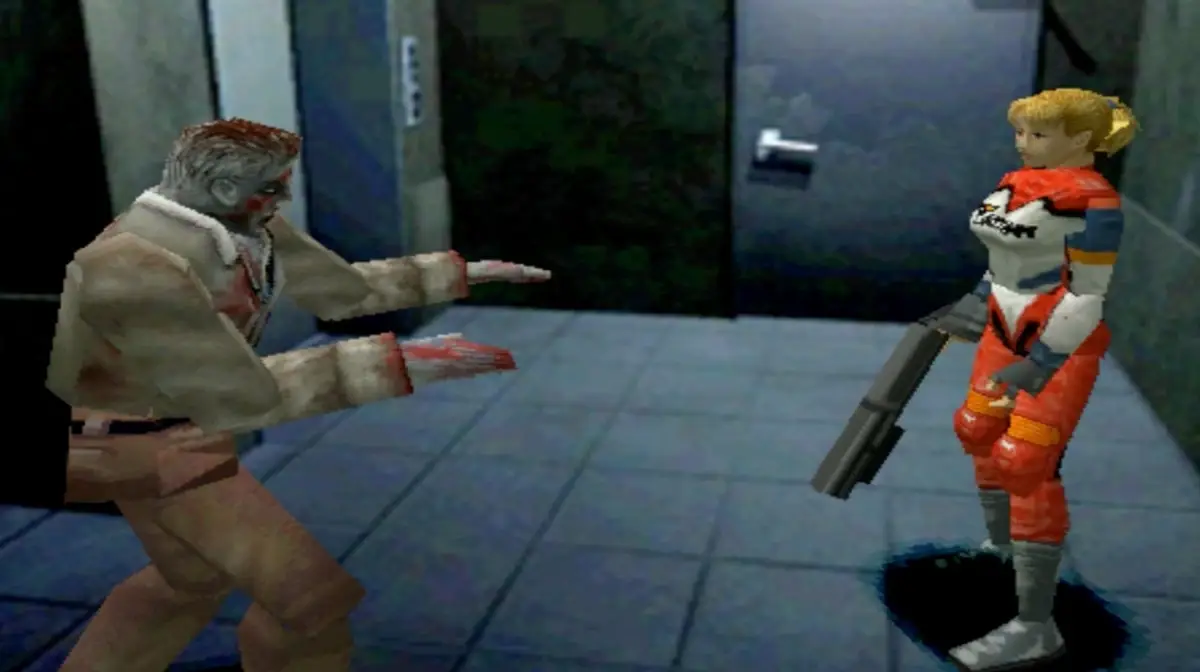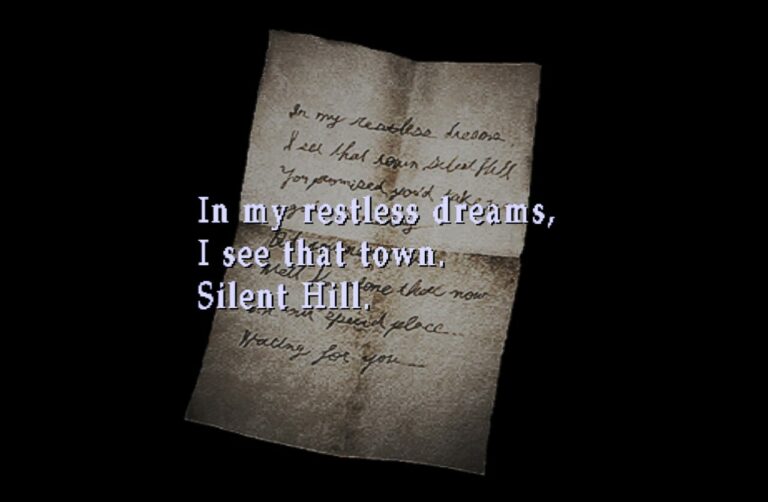After a harrowing eight-hour bus ride that included such horrors as an insane, ill woman named Portia who may have been Patient Zero, and seats with little-to-no legroom, I was more than ready to see Killing Floor 2, the sequel to one of my favorite cooperative experiences ever. It’s hard for me to mention the game without gushing extensively, so I’ll say only that I’ve spent a good few hundred hours in Tripwire Interactive’s world and have the Zed killcount to prove it. So after sprinting down San Franciscan streets to ensure I was on time for the event, I (toweled off my sweat) began chatting with Alan Wilson, Tripwire VP, who we had interviewed at E3. We laughed together, recalling his amazing ability to maintain a nine-minute long interview without actually revealing anything. After just a few short minutes, we were ushered into a small theater to begin the event in earnest.
President of Tripwire Interactive John Gibson took to the podium and gave us a brief history of Killing Floor’s origins. Alex Quick was the main creator of the mod, and had noticed that Tripwire was putting some games out as official mods for Red Orchestra, and was interested in the same happening for his creation. He knew there would be a huge jump in the size of the player base since it would be more accessible. Gibson took on the project in a weekend and the guys around the office tried the game out together. Not long afterwards they began calling each other after hours, trying to get more matches going. When they realized they needed it in their veins, they further realized that people would pay to play KF. They took three months off of RO to get KF ready for a commercial release, and set it free in May 2009. Tripwire attributed a big part of their success to the “extensive post-release support they gave the game in the form of free content packs and holiday-themed events”. Gibson went on to mention that the odd horror/comedy fusion confused most reviewers upon release but actually ended up becoming a form of cult charm for the players.
It would appear that Killing Floor 2 wants to have more of a narrative focus that its previous incarnation. The story begins one month after the “End of the Line” content pack from the first game, where the Patriarch (the main boss character) jumped onto a train over to France. Biotechnology corporation Horzine’s failed experiments have now spread across the continent of Europe, and various governments and militaries have collapsed in their attempts to contain the threat. Horzine takes up the task of cleaning up the disaster, as long as the remaining world governments pay them a handsome sum. The team recruits ex-military persons, mercenaries, and civilians to make good on these offers, which is where the players come in.
Next up to the podium was Bill Munk, Creative Director and Senior Animator to talk about the three important pillars of Killing Floor 2: Bullets, Blades, and Blood. As far as Bullets go, all weapons in the game are fully mo-capped by a man who specializes in quick reloads. He mentioned old-school classic guns, futuristic guns, and “crazy Mad Max-style weapons” (I think he meant mad scientist, though anything is possible). With Blades, Tripwire wanted to make sure that the melee combat never felt tacked on, and that if there were no guns in the game you would still want to play the game. Blood refers to the MEAT system they are implementing into the game, which stands for Massive Evisceration and Trauma. They want to have the most dynamic gore system anyone has ever seen, and I think they might have succeeded. More on that in a sec. Before stepping off to the side, Munk described Killing Floor 2 as having a certain “cool-ism” about it. He admitted the term had a certain amount of cheese to it, but went on to say that whenever they thought of something cool, it just worked in the game’s universe.
Next up was the Art Director David Hensley to explain the MEAT system. This was our first look at actual in-engine gameplay. Another team member loaded a match in the newly-revamped Biotic Labs map and was using console commands to spawn Clots (the most basic enemy type) and shut off their AI. First, we watched the player use a pistol to shoot chunks of the Clots’ faces off to reveal their skulls. While this was a cool effect in its own right, it also serves as a visual damage indicator. After spawning a SCAR, the player used another command to initiate the slo-mo “Zed time” and show us that enemies consist of nineteen different chunks that are just waiting to be blown apart in a multitude of ways. Where as the first game had five points of dismemberment per enemy, now each enemy’s head alone has five points. Shoot a skull enough and you’ll reveal brain cross-sections.
Grossed out yet? Wait til’ you see the blood.
Tripwire has found a tricky way of rendering all the crimson carnage in such a way that doesn’t tax their engine at all; if you leave a bloody mess in a room, it’ll stay there to the end of the match. They need to patent this system right away and charge every horror game designer to use it, because the days of disappearing gore are OVER. Death animations came next, where they showed that each Zed has about ninety death animations coupled with rag-doll physics. Munk later mentioned that he saw a new kill just the other day, and this comes after killing about 50,000 of the Zeds throughout development. Hensley finished up by showing that since maps now have dynamic lighting, lightbulbs and the like are now destructible. Those flashlights aren’t going to be quite so useless this time around! Other sections of the map will be destructible as well, though I’m not sure to what extent.
The team is aware that the level gaps and requirements could be long and arduous for some classes (Commando, ugh), and have made some changes accordingly. With twenty-five levels per perk, advancement will happen at a much more balanced rate. Hardcore players shouldn’t worry, as it will still take a good amount of work to max out perks. Another new addition is the Unified Experience System: for example, instead of having to do X damage with assault rifles and kill X amount of Stalkers as a Commando, now both of those actions go towards a experience bar for that perk. That way, using a perk guarantees progress with it and you won’t have to play in such a specific manner. Not all perks will start with just a 9mm pistol anymore. Every perk spawns with a unique primary weapon, a unique knife, and a unique grenade. Due to this change, the first wave won’t feel like such a throwaway. All perks still have passive abilities that grow through experience, but now every five levels you get a pair of perk skills to choose from. The first choice for Commando is between Night Vision goggles and Call Out, which allows teammates to see cloaked zeds from farther away. Support characters can choose a skill called Supplier that allows each player to reload from their backpack once per round. These skill choices help to allow players to tailor their own style to each perk and forces them to choose between self and group buffs. I like the idea of more ways to play, so hopefully these choices are always difficult and none of the skills are an obvious “gimme.”
Gibson then brought up Tripwire’s favorite subject, guns. Killing Floor has some of most satisfying weapons in the gaming industry, and has even been called “gun porn” by many. Since the weapon is the primary way the player interacts with the world in these games, Tripwire wants to make them feel as perfect as possible. When researching guns for the game, they realized that weapons with extreme rates of fire were hard to animate smoothly. Their solution was to animate these guns at 200 frames per second so that when in slow motion the weapons still have a high level of fidelity. Now you can see things as minute as the barrel wiggling with each shot.
Speaking of shots, when in Zed time, each bullet is a visible projectile with distortion rings trailing behind them. The world also desaturates in these moments and the only colors left are black, white, and red. Zed time definitely seems like it’ll feel like a cool surprise whenever it happens, though I’m sure the hardcore players will still turn it off if given the option.
Hensley came back up to show off the new melee combat. First up was the new quick strike ability: upon switching to a melee weapon, you’ll instantly unleash a fast, strong attack. Just one of these slashes was enough to cleave a Clot in two, either horizontally or vertically. Blades also accumulate blood now, and if you get tired of looking the remnants on your blade, a tap of the reload button will flick the blood off. Reloading a clean blade performs an flourish. I can already see myself doing this entirely too often.
The melee no longer looks arbitrary and ineffective. Each weapon now has its own timing for combos and there are different moves are assigned to the movement keys. You can also use light and heavy attacks along with a block and parry system. Berserkers rejoice, for if this all feels as good as it looks, your favorite Perk just got a major upgrade.
After showing us the melee, Hensley gave us more details on the way difficulties are going to change the Zed’s behaviors. The AI was reactivated and the Clots began their slow pursuit of the player, quickly succumbing to the provided hail of gunfire. This was Normal difficulty, so that wasn’t unexpected. The player then loaded the Burning Paris map on ‘Hell on Earth’ difficulty. Clots immediately moved faster and charged when shot at, and utilized leap and lunge attacks that weren’t present on Normal difficulty. Every Zed gains new abilities like this on harder difficulties to avoid the problem most games have where hard mode just means the enemies have more health. I can’t wait to see what new tricks the bigger enemies pick up.
Up until this point, we were shown how each system worked in isolated incidents. The team then decided it was time to show us how Killing Floor 2 looks in action. And holy shit.
One of the songs in the first game started playing, and everything came together gloriously. The light provided by the flaming city made the new enemy designs seem infinitely more menacing, and we were right back to that familiar, chunky Killing Floor feel that is so loved. Any pretense of a professionalism bled out of me and I probably made a couple of fanboy squeal noises. After the first wave, we found out that the Trader has been replaced by a 3D printer that you can “download” weapons from, though a new trader will be shown on a screen. The person demoing the game for us was quickly wiped out on the second wave. Zeds seem fiercer, hungrier, and more determined. There’s an overall faster pace, so the addition of a sprint command is appreciated. We watched the demonstrator try a couple more times, but he was killed by both the mutants and the crashes present in the Alpha build.
With his death came the end of the presentation. But I like you guys, so I have a few things I noticed during the demonstration that I’d like to share. Some of it is the result of questioning, and some is simply speculation. First off, and here’s the big one: there are left and right bumper prompts in the lobby menus. When I grilled the developers, they didn’t confirm or deny anything. I don’t want to promise anything as this could be something as simple as controller support for PC, but I’m thinking we’re going to be seeing Killing Floor 2 on consoles. There’s also a gear tab in the lobby menu. I asked if these were simply for skins like in the previous game or if there was more to it, and they said they had “no comment at the moment, but if you look at the new screenshots, you’ll notice that the same characters are wearing different clothes.” I’m not sure how new gear is earned or if it does anything besides provide new cosmetic options, but I’m sure we’ll be hearing more about that soon. And here’s the rest of what I learned in sexy bullet point form:
- For you gun nuts, returning weapons that I personally saw include the AA-12, SCAR, 9mm pistol, Katana, Bullpup and Hunting Shotgun (now called the Boomstick Shotgun and it looks much more ornate).
- New weapons include the MB-500 Shotgun, the AK 12, and the AR 15.
- The skills section of the demo focused on the Commando, and I saw skills called Night Vision, Call Out, Large Mags, Tactical Reload, Impact, and Zed Time – Professional.
- Six of the ten perks were blacked out…except for their little icons. I can definitely say that sharpshooter and dual pistols are different perks now. I also saw a few other things, but let’s save some surprises for Tripwire!
- During the course of the demo, when a certain amount of Zeds were killed, a message flashed across the screen saying “Tier Unlocked.” Perhaps you can’t buy high tier weapons until you’ve killed enough Zeds?
That’s all I have for now. This lack of a release date is killing me. I want to get my hands on Killing Floor 2 as soon as I am physically able. What I saw looks like the perfect combination that will satisfy both veterans of the series and newcomers.
Full Disclosure: Tripwire Interactive hosted a Killing Floor 2 event in San Francisco that I attended this week, which they supplied some accommodations for.

